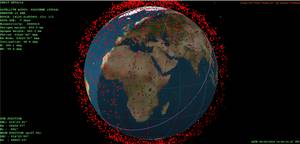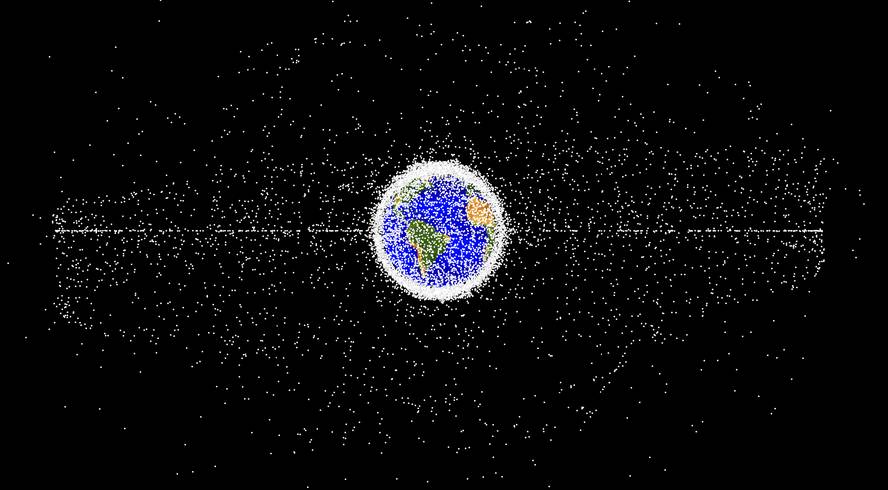Trapped on Earth: Space Junk and the Future of Space Missions
2024/06/01 Iñigo González de Arrieta Martínez - EHUko Fisika Saila | Iker González Cubiella - Xabier Zubiri - Manteo BHIko irakaslea Iturria: Elhuyar aldizkaria
The Moon is known to be the only natural satellite orbiting our planet, but there are many other man-made satellites, artificial satellites. Telecommunications, meteorology, espionage -- countless. But what happens when all these artificial satellites come to death? The motto to reduce, recycle, reuse is not worth space. Gravity (2013) published the dangers of the sky being filled with space debris. In it, the satellite collision caused the satellites to fragment into thousands of small fragments (called micrometeoroids) that began to orbit at high speed, giving rise to enormous headaches to Sandra Bullock to return to Earth. Apart from science fiction, the proliferation of these micrometeoroids has aggravated the space sector (Figure 1). What if one day the density of meteoroids reached a critical value, too big to be able to leave Earth without harm?
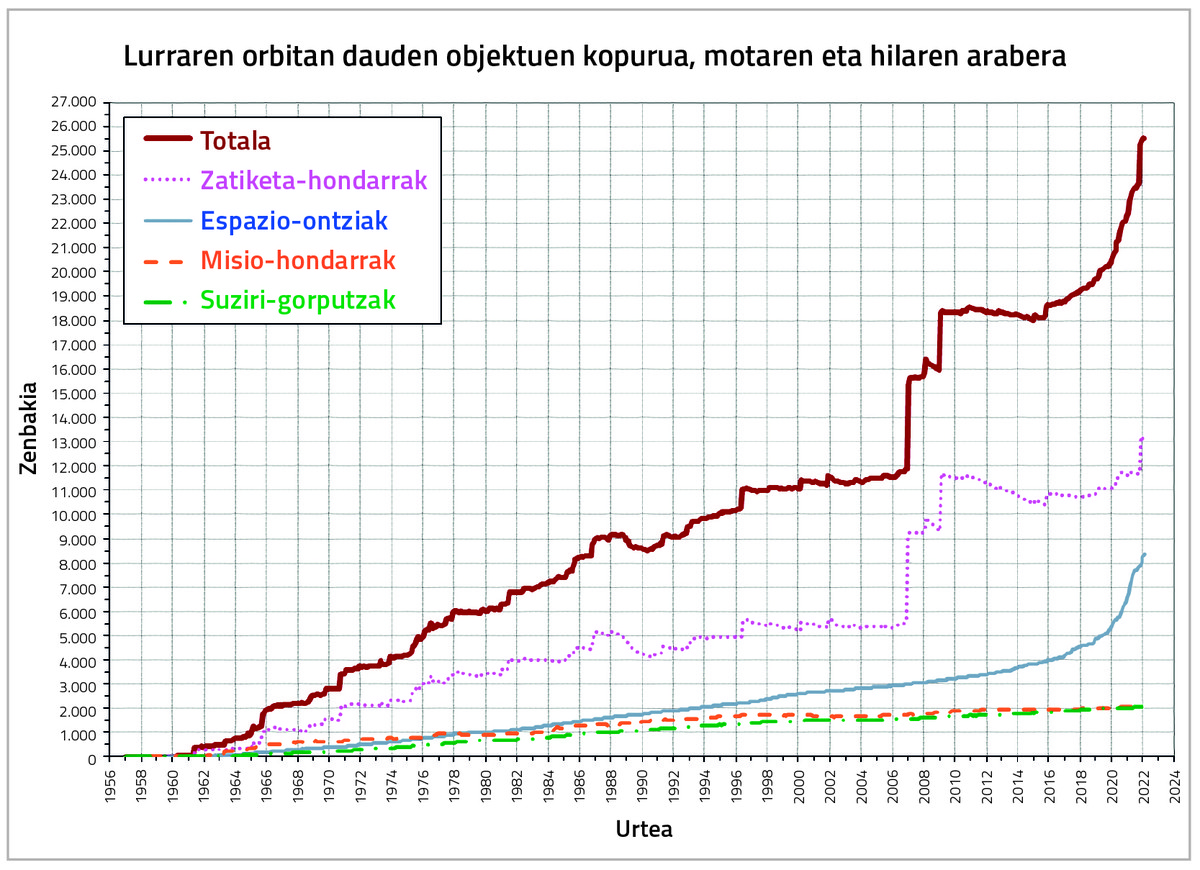
This hypothetical problem is called Kessler Syndrome, proposed in 1978 by Donald Kessler and Burton Cour-Palais. The researchers calculated the amount of garbage that can be generated as a result of collisions between space garbage. His model predicted a critical chain reaction density in which the growth of micrometeoroids becomes exponential (like a nuclear bomb). Once this point has passed, the sky will be filled with trash and humans will be forced to stay on the final Earth. However, so far we have not reached the situation described in this calculation, but the trend is changing rapidly. In a new example of the baths tragedy dilemma, the number of objects sent to space is not being reduced, but is increasing, especially by megaprojects such as the Starlink of Space X. Therefore, given all this, it seems very likely that the Kessler prediction will come true. Through this article we will try to analyze the feasibility of this problem through current forecasts.
Analyzing the severity of the problem
Like the interior of the Earth, the exterior is divided into layers. The distance from the Earth's atmosphere to the Van Allen belt is called the Lower Earth Orbit (LEO) and is approximately 2,000 km from the Earth's surface. Half of the residues in this orbit come from two collisions: ASAT test (conducted by China in 2007 by satellite explosions missile) between Kosmos 2251 and Iridium 33. Throughout LEO, US Space Force recorded 22,936 objects in 2022 (Figure 2). However, this figure is very much neglected:The European Space Agency estimates that in LEO there are 130 million objects over 1 mm.
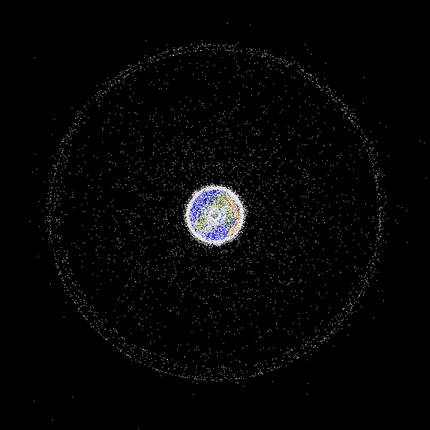
Far further away, at 35,786 km, is the Geosynchronous Orbit (GEO). The objects of this orbit move proportionally to the rotation of the Earth, so they always appear in the same point of the sky from our point of view. This is essential for communications satellites and climate monitoring satellites, as it allows their positions to be monitored at all times. They also make it possible to set fixed reference points for other satellites, such as GPS, which orbit closer to Earth but which must ensure the traceability of positions. Figure 2 shows the different types of orbits: The cloud next to Earth is called LEO, and the ring that looks nicely marked on the outside is GEO. Among them is the central orbit (MEO), where there are global navigation systems such as GPS. Finally, few points are observed outside the geosynchronous orbit, in orbits called cemeteries. In these orbits, the satellites that have ended their operational life are left so that they do not interfere in the GEO orbit.
The characteristics of orbits are very important for understanding the state of space junk. Apart from the technical aspects of each type, the air friction levels are also very different. This phenomenon is called orbital deterioration and is observed by all bodies in Earth orbit. The deterioration of the LEO orbit is remarkable, and the satellites contained therein require thrusters to remain in orbit. Therefore, the trash of the lower Earth orbit will return to our atmosphere within approximately 25 years. However, in the geosynchronous orbit, the density of gases is very low and the decline of space junk is much slower. This means that overpopulation of satellites and space garbage generation will be much more difficult to manage in this important orbit.
However, unlike Kessler, there was only one collision of large satellites once in 2009. Analyzing the data, the calculations seem to have overestimated the likelihood of such a shock. Being the primary way to generate space garbage, many believe that the fear of getting stuck on our planet is unfair. However, this only describes the business-as-usual situation, which is not guaranteed. In fact, the number of spacecraft has increased considerably in the last decade, as shown in Figure 1. Both the militarization of the lower Earth orbit as proposed and Starlink set a worrying precedent that we will analyze in the next section.
New members of the space: Starlink, armies...
Although the current situation does not seem too serious, we have reason to fear an aggravation process. On the one hand, India has followed China's footsteps and tested the weapon against its satellites in 2019. It seems that the US monopoly on military satellite technology is coming to an end, and there are not a few armies that want to participate in this new scenario of potential conflict.
On the other hand, if the Starlink project by Elon Muskiz is implemented, we will have 50,000 new satellites orbiting our planet and the likelihood of collision will be higher. Communications satellites from previous generations were located in orbit GMOs, so their signals took longer to reach and did not allow massive generalization of fast satellite Internet. In November 2018, the US Government authorised Elon Muskiz to launch 7,518 satellites in LEO. In February 2024, 5,289 Starlink satellites are already in operation, with over 2 million subscribers. At the moment, this massive increase in the number of satellites has not led to a significant increase in garbage, but if you follow this trend it seems that it is a matter of time for the chain reaction of space junk announced by Kessler.
Requests have already been received in the International Telecommunication Union for less famous but far greater constellations than Starlink, such as the Cinnamon 937 constellation of 337,000 satellites submitted by Rwanda. There are orders for more than 90 constellations of more than a thousand satellites and, taking into account all requests, they estimate that the number of satellites in orbit would increase to 115 times.
What to do? Active and passive waste management
At this point it is clear that at the moment it is not possible to generate less waste, and many proposals have been made to remove waste. As we have seen, different management methods are needed for each type of orbit. Due to orbital deterioration, the LEO litter falls to Earth relatively quickly, but this is not so easy for GMO satellites, which have a half-millenary life. Therefore, in order to protect this orbit, it is necessary that these vessels move to other orbits, called “funeral orbits”. However, funeral orbits are also noticing a problem of overpopulation. Active orbital cleaning technologies have therefore been developed.
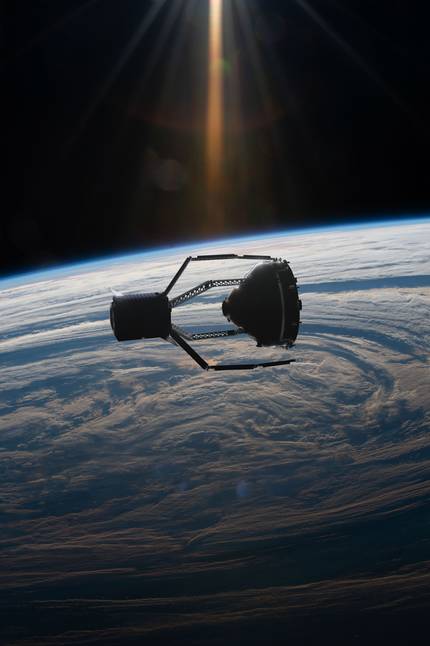
Other forms of garbage collection have also been proposed: harping or nets to recover satellites, collecting them by magnets or using lasers to warm up the satellite and increase orbital deterioration. Unfortunately, most of the proposals can only be found in the scientific literature at the moment, without operational prototypes. However, it should be noted that the most developed prototypes so far include a ESA design, ClearSpace-1 (Figure 3). This method physically runs large remnants of satellites and rockets before it falls to Earth and is expected to start operating in 2025. If so, it would be the first system that works to clean the orbits, which would show that we are still in time to avoid a disaster.
Are there reasons to worry?
It is difficult to predict the magnitude of the problem in the long term, as it depends on the plans for the use of the space of governments, large companies and armies. It is, however, perfectly clear that, like land waste management, space waste management will also be crucial. As the number of satellites goes up, the likelihood of collisions and chain reactions will increase, and anyone knows the consequences. Although space missions can continue in the near future, cost growth can make the exploitation of space unfeasible, both from a scientific and commercial point of view. It is important not to forget this and not to jeopardise the possibility of enjoying long-term space for immediate economic benefits. We have begun to notice 50 years after climate change and some consequences are already irreparable. Let's not leave this problem of space garbage to our future generations, and let's fix it before it's too late.
Bibliography
[1] Zientzia.eus. (2014). Space junk. https://zientzia.eus/artikuluak/zabor-espaziala/
[2] Wall, M. (2022). Kessler Syndrome and the space debris. https://www.space.com/kessler-syndrome-space-debris
[3] United States Space Force (2023) – processed by Our World in Data: “Objects in space”. https://ourworldindata.org/grapher/low-earth-orbits-objects
[4] Etxebeste, E. (2023). They warn of the need to maintain the rise of satellites. Elhuyar aldizkaria, 352.
[5] McDowell, J. Starlink Launch Statistics. https://planet4589.org/space/con/star/stats.html
[6] Shan, M., Guo, J., & Gill, E. (2016). Review and comparison of active space debris capture and removal methods. Progress in Aerospace Sciences, 80, 18-32.
[7] Adilov, N., Alexander, P. J. Cunningham, B. M. (2018). An economic “Kessler Syndrome”: A dynamic model of earth clubdebris. Economics Letters, 166, 79-82.

Gai honi buruzko eduki gehiago
Elhuyarrek garatutako teknologia





